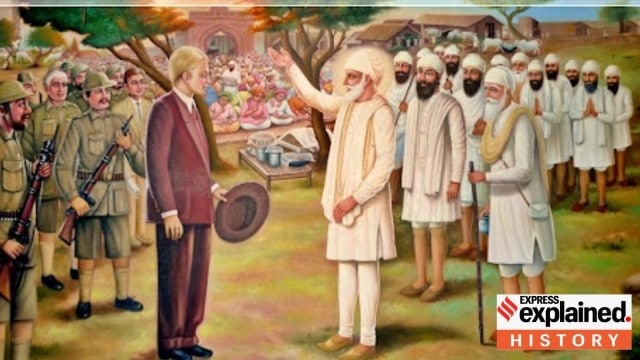What is the history of the Kuka martyrs’ day?
Who are the Namdharis? Why were 66 Namdharis executed by the British in 1872? What is the sect’s status today?
 The British retribution to the Kuka raids was brutal. John Lambert Cowan, the Deputy Commissioner of Ludhiana district, ordered the execution of 49 Kukas on January 17, and another 17 on January 18. The Kukas were placed in front of cannons, and blown up in an open field, in front of thousands of onlookers. (Representative/Wikipedia)
The British retribution to the Kuka raids was brutal. John Lambert Cowan, the Deputy Commissioner of Ludhiana district, ordered the execution of 49 Kukas on January 17, and another 17 on January 18. The Kukas were placed in front of cannons, and blown up in an open field, in front of thousands of onlookers. (Representative/Wikipedia)
Punjab Chief Minister Bhagwant Mann on Friday (January 17) afternoon paid tribute at a function organised at the Namdhari Shaheed Smarak in Malerkotla to mark the Kuka martyrs’ day. On January 17 and 18, 1872, some 66 Namdhari Sikhs, also known as Kukas, were executed — placed in front of cannons and blown up — in the town.
Who are the Namdharis?
Contrary to popular perceptions, Indians continued to pick up arms against the British in the decades following the Rebellion of 1857. These movements were localised, and hence put down easily by the colonial power.
One such rebellion was led by Namdharis in Punjab. Also called kukas because of their trademark high-pitch style of reciting the Gurbani — kook in Punjabi refers to “screaming” or “crying” — the Namdharis were a Sikh sect founded by Satguru Ram Singh in Ludhiana on April 12, 1857.
Ram Singh challenged the status quo in Punjab, and preached against various social vices, especially the consumption of alcohol and meat. He also launched what can be called a predecessor of the Swadeshi and Non-Cooperation Movements of the early 20th century — he called his supporters to boycott foreign goods, British services and educational institutions, among other things.
It was this movement which, by the 1870s, saw sporadic instances of violence between the Namdharis and British officials or natives working for the British. This culminated in the events of January, 1872.
What happened in January 1872?
On January 13, 1872, a group of some 200 Namdharis led by Kuka Hira Singh and Lehna Singh reached Malerkotla following an incident of cow slaughter in the town. The Namdharis had long been agitating for a ban on cow slaughter.
On January 15, the Kukas clashed with government officials. Both side reported injuries. The On the very same day, a 150-strong Kuka contingent also attacked the Malaudh Fort in Ludhiana, which was under the jurisdiction of a local ruler who was loyal to the British. This attack too was repulsed. A number of Kukas eventually surrendered.
The British retribution to the Kuka raids was brutal. John Lambert Cowan, the Deputy Commissioner of Ludhiana district, ordered the execution of 49 Kukas on January 17, and another 17 on January 18. The Kukas were placed in front of cannons, and blown up in an open field, in front of thousands of onlookers.
“Of the 66 martys, one was 12-year-old Bishan Singh. Cowan offered to spare him if he renounced his sect. Not only did he refuse to do so, the young boy tugged Cowan’s flowing beard. As a result, Bishan Singh’s hands were first chopped off, before he was struck down with swords,” Namdhari Navtej Singh told The Indian Express.
Another story of Kuka bravery pertains to Waryam Singh, a short but courageous man from Patiala. Given his physical stature, Waryam did not reach the mouth of the cannon. “He himself brought a few stones from a nearby field to stand on, so the cannon fire into his body,” Navtej Singh said. “Such was the dedication of Namdharis… they were willing to sacrifice their lives but refused to bow to the British,” he added.
Namdharis after Kuka revolt
After the incident, Satguru Ram Singh and other chiefs were exiled in Rangoon (present-day Burma), from where they never returned. A core belief of the Namdharis is that Ram Singh is still alive, and will return one day. Until then, they mourn his absence by wearing white.
There are some two lakh Namdharis in Punjab today, although the sect has seen an internal schism since the death of Satguru Jagjit Singh in 2012. Some supporters have rallied behind Thakur Dilip Singh, who is headquartered in Sirsa, Haryana. Others follow Sangrur Uday Singh, who is headquartered at Bhaini Sahib in Ludhiana, the original seat of the Namdharis.
- 01
- 02
- 03
- 04
- 05






































